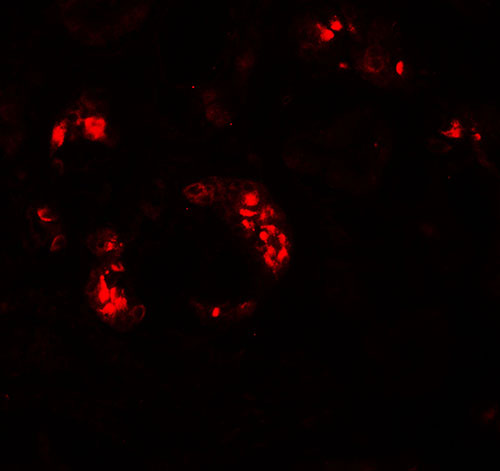KANK2 Antibody
- 产品详情
- 实验流程
- 背景知识
Application
| WB, IF, E, IHC-P |
|---|---|
| Primary Accession | Q63ZY3 |
| Other Accession | NP_056308, 258613875 |
| Reactivity | Human, Mouse, Rat |
| Host | Rabbit |
| Clonality | Polyclonal |
| Isotype | IgG |
| Calculated MW | 91174 Da |
| Concentration (mg/ml) | 1 mg/mL |
| Conjugate | Unconjugated |
| Application Notes | KANK2 Antibody can be used for detection of KANK2 by Western blot at 1 µg/mL. |
| Gene ID | 25959 |
|---|---|
| Other Names | KN motif and ankyrin repeat domain-containing protein 2, Ankyrin repeat domain-containing protein 25, Matrix-remodeling-associated protein 3, SRC-1-interacting protein, SIP, SRC-interacting protein, SRC1-interacting protein, KANK2, ANKRD25, KIAA1518, MXRA3, SIP |
| Target/Specificity | KANK2; Two alternatively spliced transcript variants encoding different isoforms have been identified. |
| Reconstitution & Storage | KANK2 antibody can be stored at 4℃ for three months and -20℃, stable for up to one year. |
| Precautions | KANK2 Antibody is for research use only and not for use in diagnostic or therapeutic procedures. |
| Name | KANK2 |
|---|---|
| Synonyms | ANKRD25, KIAA1518, MXRA3, SIP |
| Function | Involved in transcription regulation by sequestering in the cytoplasm nuclear receptor coactivators such as NCOA1, NCOA2 and NCOA3 (PubMed:17476305). Involved in regulation of caspase-independent apoptosis by sequestering the proapoptotic factor AIFM1 in mitochondria (PubMed:22371500). Pro-apoptotic stimuli can induce its proteasomal degradation allowing the translocation of AIFM1 to the nucleus to induce apoptosis (PubMed:22371500). Involved in the negative control of vitamin D receptor signaling pathway (PubMed:24671081). Involved in actin stress fibers formation through its interaction with ARHGDIA and the regulation of the Rho signaling pathway (PubMed:17996375, PubMed:25961457). May thereby play a role in cell adhesion and migration, regulating for instance podocytes migration during development of the kidney (PubMed:25961457). Through the Rho signaling pathway may also regulate cell proliferation (By similarity). |
| Cellular Location | Cytoplasm. Mitochondrion |
| Tissue Location | Strongly expressed in cervix, colon, heart, kidney and lung. Expressed in kidney glomerular podocytes and mesangial cells (at protein level). |
For Research Use Only. Not For Use In Diagnostic Procedures.
Provided below are standard protocols that you may find useful for product applications.
BACKGROUND
KANK2 Antibody: Ankyrins are membrane adaptor molecules that play important roles in the control of cytoskeleton formation by regulating actin polymerization. KANK2 (KN motif and ankyrin repeat domain-containing protein 2), was initially identified as a steroid receptor coactivator (SRC) interacting protein (SIP) that could sequester steroid receptor coactivators in the cytoplasm. More recent experiments have shown that while KANK2 is widely expressed, in kidney podocytes, KANK2 localizes to foot processes, suggesting that KANK2 may contribute to controlling actin dynamics in podocyte foot processes.
REFERENCES
Zhu Y, Kakinuma N, Wang Y, et al. Kank proteins: a new family of ankyrin-repeat domain containing proteins. Biochim. Biophys. Acta 2008; 1780:128-33.
Roy BC, Kakinuma N, Kiyama R. Kank attenuates actin remodeling by preventing interaction between IRSp53 and Rac1. J. Cell Biol. 2009; 184:253-67.
Zhang Y, Zhang H, Liang J, et al. SIP, a novel ankyrin repeat containing protein, sequesters steroid receptor coactivators in the cytoplasm. EMBO J. 2007; 26:2645-57.
Xu X, Patrakka J, Sistani L, et al. Expression of novel podocyte-associated proteins sult1b1 and ankrd25. Nephron Exp. Nephrol. 2011; 117:e39-46.
终于等到您。ABCEPTA(百远生物)抗体产品。
点击下方“我要评价 ”按钮提交您的反馈信息,您的反馈和评价是我们最宝贵的财富之一,
我们将在1-3个工作日内处理您的反馈信息。
如有疑问,联系:0512-88856768 tech-china@abcepta.com.























 癌症的基本特征包括细胞增殖、血管生成、迁移、凋亡逃避机制和细胞永生等。找到癌症发生过程中这些通路的关键标记物和对应的抗体用于检测至关重要。
癌症的基本特征包括细胞增殖、血管生成、迁移、凋亡逃避机制和细胞永生等。找到癌症发生过程中这些通路的关键标记物和对应的抗体用于检测至关重要。 为您推荐一个泛素化位点预测神器——泛素化分析工具,可以为您的蛋白的泛素化位点作出预测和评分。
为您推荐一个泛素化位点预测神器——泛素化分析工具,可以为您的蛋白的泛素化位点作出预测和评分。 细胞自噬受体图形绘图工具为你的蛋白的细胞受体结合位点作出预测和评分,识别结合到自噬通路中的蛋白是非常重要的,便于让我们理解自噬在正常生理、病理过程中的作用,如发育、细胞分化、神经退化性疾病、压力条件下、感染和癌症。
细胞自噬受体图形绘图工具为你的蛋白的细胞受体结合位点作出预测和评分,识别结合到自噬通路中的蛋白是非常重要的,便于让我们理解自噬在正常生理、病理过程中的作用,如发育、细胞分化、神经退化性疾病、压力条件下、感染和癌症。








